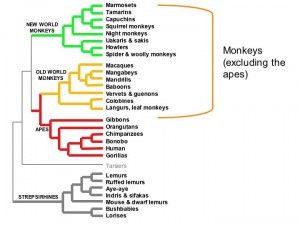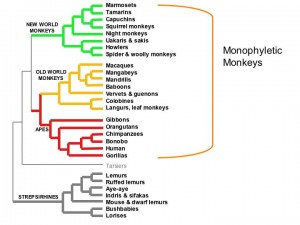Think of a monkey.
What do you see?
I bet that most people picture a chimpanzee, most likely a juvenile chimpanzee, like Curious George (who in the books is always called a monkey). Even though adult chimpanzees look rather like small gorillas – they walk on all fours, they are nearly as big as people, and they are tremendously strong – most people seem to think of chimps as “cute little monkeys.” The monkeys in a Barrel of Monkeys are chimps. Do a Google Images search for “monkey” and you will get some pictures of proper monkeys, but you will also get lots of chimps.
Anyone who knows something about primates, though, knows that chimpanzees are not monkeys. They are apes. And what are apes? They are a group of primates from the Old World (Africa and Eurasia) that don’t have tails. There used to be many more species of them, millions of years ago, but now we just have twenty-odd species, most of which are different kinds of gibbons, plus siamangs, orangutans, gorillas, chimpanzees, bonobos, and humans.
For many years, people used the word “ape” to mean the group of Old World primates that didn’t have tails, but that weren’t humans: that is, all of the apes except us.

More recently, biologists have argued that when we classify living things, we should use only monophyletic groups: groups in which all members are descendents of a common ancestor. Since humans evolved from apes, then, strictly speaking, we are apes.
So what about monkeys? If the term “monkey” does not include the apes, then it is no longer a monophyletic group. A good monophyletic group should include all of the descendents of a common ancestor. In the jargon of taxonomy, Old World monkeys and apes are classified together as Catarrhines (“downward noses”), while monkeys from the New World (North and South America) are classified as Platyrhines (“flat noses”). These are good monophyletic groups. But nobody uses jargon like this in ordinary language. If we translate these terms into ordinary language, we get Old World monkeys (which, to be monophyletic, must include the apes) and New World monkeys. So apes are all monkeys. Which makes you and me monkeys. And any man whose siblings have reproduced is a monkey’s uncle.
So I suggest that we rehabilitate the word “monkey” as a perfectly good word to use in describing chimpanzees and all the other apes, including us. Apes are just one particular branch of the monkey family tree.
When I discussed this in class this spring, one of my students complained that officially classifying apes as monkeys would rob him of the pleasure of correcting strangers at the zoo when they go around calling gorillas and orangutans “monkeys.” To me, though, this seems like a happy case in which ordinary language fits perfectly well with good biology.
This doesn’t always have to be the case. I expect it will take people a while longer to get used to the idea that birds are dinosaurs, and that, monophyletically speaking, we are all fish.

Yay! Thank you! I’ve been struggling with this as my toddler learns his animals. “Monkey!” he says as he points to a picture of a chimp. And I want to say “yes!” because he’s got the main primate concept down. But I also want to say “well, no, that’s a chimp” because well, you know, chimps aren’t *monkeys*. (But then how am I supposed to explain the difference between chimps and monkeys to a 1-year-old?) Now I can say “yes!” to all those chimps and orangutans he calls monkeys without squirming. Thanks!
As long as you get the finer taxonomic points worked out before preschool, he’ll be fine!
Interesting and helpful. It’s pretty common, I think, that an ordinary common noun gets used for both a genus (in the ordinary, non-biological sense) and a species of that genus. Sometimes one and the same person will use the word in both ways, depending on the context. Sometimes, though, some people favor one use, others another. (Maybe Bert Vaux can help with examples.) As you point out, this is definitely true of ‘monkey’, and it generally seems to be of the second type, where some people favor the broad use and others are convinced that the broad use is wrong. But your post suggests that there are good biological reasons for both the broader use of ‘monkey’ (all apes are part of the monophyletic monkey class) and the narrower use (apes constitutes a monophyletic class that excludes other members of the monophyletic monkey class). So we should all think of it as one of those genus-and-species-signifying common nouns of the first type, and permit both the broader and narrower use of the word ‘monkey’.
Against that, you seem to think that the narrower use of ‘monkey’ is not biologically kosher, since that use of the term does not pick out a monophyletic class. But there is some use, is there not, in picking out the remainder of a monophyletic class from which a monophyletic subclass has been subtracted? Maybe not sufficient use to tolerate the potential confusion. However that may be, your more fastidious position reminds me of Plato, who devotes two dialogues (Sophist and Statesman) to the difficulties of making divisions that classify appropriately and goes out of his way to insist that some divisions “cut nature at its joints” (his metaphor for the method of division at Phaedrus 265e), whereas others do not (his example is Greek/non-Greek [barbaros], which he rejects because ‘barbaros’ is not a real kind [Statesman 262c-263a]).
Good points, Eric.
It’s true that the narrower use of ‘monkey’ is not kosher, as it is paraphyletic (it excludes apes). BUT I think it’s a fine term, as long as you recognize it as grade, rather than a clade.
Grades are groups of organisms that are defined by some apparent stage of evolutionary development, rather than membership in a clade (descendants of a common ancestor). So if you use ‘reptile’ in a way that excludes birds, you are talking about a grade; cold-blooded animals with scales that creep and crawl. As a clade, ‘reptile’ has to include birds, since birds evolved from dinosaurs, which evolved from earlier reptiles. That’s a case where good biology and common language use don’t agree very well. But I think it’s fine to use ‘reptile’ and other words to refer to grades in ordinary speech, since otherwise nobody will understand what you are talking about.
(But talking about dinosaurs as ‘reptiles’ probably gives the wrong idea, since they were probably more like birds than lizards in many important ways. They didn’t creep and crawl — they stood up on erect legs, they scampered about (at least the smaller ones did), and many of them had feathers and may have been warm-blooded.)
Oh, and I don’t deserve any credit for this “fastidious position” — it comes out of work by many people in evolutionary systematics, like Willi Hennig, and is now just mainstream taxonomic thinking.